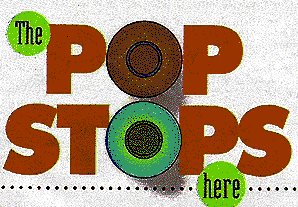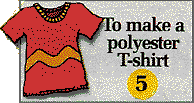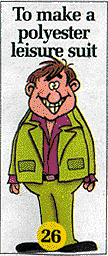What goes around Comes around.
To Use Reused or not to Use Reused,
That is the question.
![]()
Facts about recycled content products
| MYTH | Recycled products aren't as good as non-recycled products |
|---|---|
| F A C T |
Recycled content products share the same performance characteristics as their non-recycled equivalent. They usually look no different and offer the same functionality as non-recycled products. A survey of purchasing agents showed that 97% were pleased with the performance of recycled content products. |
![]()
If You Aren't buying recycled,
You aren't recycling.
Buying recycled products ensures a market for collected recyclables, creates less less waste and demands less energy than using virgin materials. Increasing demand for recycled-content products also creates economies of scale in collection and manufacturing. Market demand means that recycled-content products are no longer "specialty" but rather &" items, which are regularly stocked on store shelves. As with products, market demand also leads to increases in quality and decreases in cost.
And remember to look for the recycled content symbol on products and packages.
![]()
Re-refined is right for you
Motor oil doesn't wear out - it just gets dirty. Used oil can be cleaned of contaminants, such as dirt, water, fuel and additives. Once the oil is cleaned, the base oil is used as the main ingredient in new motor oil. Used oil can be re-refined over and over again.
Currently, about 14 percent of used oil is re-refined. The remainder goes for a variety of other products and uses.
It only takes about 1 gallon of used motor oil to create 2 quarts of re-refined oil. Compare that to the 42 gallons of crude oil required to make the same 2 quarts of virgin oil. Plus, re-refining uses half as much energy.
Re-refined oil is subject to the same refining, mixing and performance standards as virgin oil Next time you buy motor oil at a retail store or have your oil changed at a service center, ask for re-refined oil.
For more information, visit the American Petroleum Industries web site, http://www.api.org/pasp/recycleoil/
![]()
If you buy it...
Remember the movie Field of Dreams? The main character plows under his corn to build a baseball field because he keeps hearing someone say "If you build it, he will come." A similar sentiment applies to recycled-content products: If you buy them, stores will keep stocking them, manufacturers will keep making them and communities will keep collecting the raw materials, your recyclables.
![]()
Buying recycled is easy.
Thousands of products are made from recyclables- just look at the labels. Make it your goal to buy products that say "Post-consumer recycled content" on the labels. This means that raw materials used to make the product were once used by someone else and recycled in a community recycling program.
Whether the raw material was a milk jug or a newspaper,
![]()
The Proof is in the Reuse
Packaging comes in many forms.
Cardboard, paperboard, wood, plastic and others are used to contain, protect, inform costumers and allow for easier use of the product. While all of these uses are beneficial, packaging can represent too much of a good thing. Packaging overuse leads to increased waste production, recycling difficulties and higher product and packaging prices, as well as wasteful use of resources in the production of new packaging.
The production of large quantities of packaging is unnecessarily using huge amounts of resources, By reusing what we use, we reduce the need for more packaging to be made.
To combat this packaging waste some companies have been using reusable packaging. Pepsi-Cola now uses plastic crates to transport two liter bottles instead of single use corrugated boxes. The company estimates that it saves millions of dollars in reduced packaging costs, as well as 80,000 to 90,000 tons of corrugated cardboard. Even though reusable containers may cost more up-front than single use packages, the long term cost is usually much lower.
Companies can also save money in disposal fees, decreasing product damage and storage costs by using reusable packaging. In addition, the reusable packages can have more than one type of use. For example, some reusable manufacturers have provided crates that have a dual function for produce farmers. The produce growers ship their produce in reusable crates, and then the crates are converted into display cases at the supermarket.
![]()
Be Part Smart
The remote control just quits one day. A plastic part pops off a toy. A china coffee cup slides from the counter to the floor, pieces flying.
Things break and get lost. That doesn't mean that you need to replace the television, the toy, or the dishes. Instead, look for replacement parts.
Begin with the product manufacturer. Many manufacturers provide free or low cost repair and replacement parts and ship them directly to you. Most manufacturers have a toll free number or website, so that you can contact them at no charge. For some products, such as cars trucks, parts stores carry replacement parts locally.
If the manufacturer can't provide the part, try a repair shop or scrap dealer. Repair shops and scrap dealers often have parts and accessories on hand. Check with antique and second hand stores, as well. Garage sales and on-line auction sites are another place to look.
If you still can't find what you're looking for, search for "replacement parts" along with the item name on the internet. You might find that several sites provide information about or sell parts. For instance, Replacements, Limited carries more than 137,000 patterns of china, crystal, and silver. If you break or lose a piece or two, they can provide a list of pieces available in your pattern, as well as the replacement cost. For more information about them, visit http://www.replacement.com or call 1-800-Replace. Another company, North American Accessories (1-800-813-2395), searches for accessories for televisions, computers, cell phones, and more. They specialize in parts no longer made carried by the original manufacturer.
![]()

To Grocery Stores and beyond, plastic bottles are finding their way into the recycled-content marketplace. |
|
 |
 |
 |
 |
 |
|
![]()
Compost By Mail
The United States Postal service has begun yet another program to reduce it's waste. After collecting tons of undeliverable mail, such as letters, magazines, catalogs and newspapers, they have begun a project that will compost this material in Texas. These kinds of paper can act as the necessary carbon component in the compost.
to test the usefulness on the soil enriching compost, researchers will be growing tomatoes with it. Yield, growth and toxic effects, if any, on the tomatoes will be closely studied.
![]()
![]()
![]()
![]()
Special thanks to Ecopartners Inc.
And the Ontario Co. branch of the
Cornell Cooperative Extension in
Canandaigua New York
for allowing me to reprint their Quarterly NewsLetter
distributed for Ontario County Dept. of Solid Waste Management.